Scott Lumen Review | An XC eMTB Stealth Rider
The Scott Lumen eRIDE 920 is a light and snappy ride. This XC/trail setup handles with confidence, yet passersby might not even clock it as a full-suspension or electric bike.
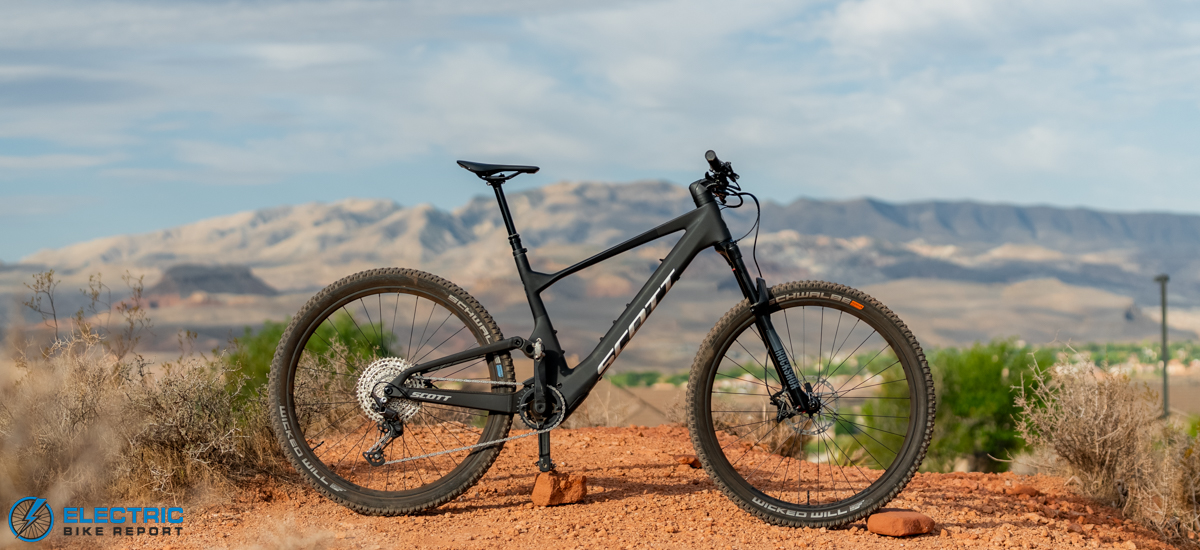
Lightweight, nimble, and agile: these are not words we usually associate with e-bikes, where a motor and battery often add bulk. You might think that would make an e-bike the opposite of what a cross-country or trail rider wants, but build it right and it can enhance the experience rather than hinder it.
Enter the Scott Lumen eRIDE: a bike with a carbon frame that keeps it featherlight (relatively) and responsive, and a compact, whisper-quiet motor that gives your ride a little extra kick.
Scott equipped this XC/trail bike with a few clever touches to elevate the ride. The integrated suspension hides the shock inside the frame, offering 130mm of travel that’s nearly invisible at first glance. The fork adds another 140mm of travel, and with Scott’s TwinLoc system you can adjust both on the fly switching between traction control (shortened travel) or a full lockout for efficient pedaling when the trail smooths out.
But the Lumen’s best trick lies in its motor choice. The TQ HPR50 system is praised for how naturally it amplifies your effort and never overpowering it. It feels like you, just in top form: stronger on climbs, smoother on flats, and grinning the whole way, with almost no motor noise to pull you out of the moment. The smaller, lighter battery keeps the overall weight low (41 lbs on our test model), preserving that crisp handling XC riders expect.
As Scott’s entry-level model, some components are solid but not standout, tires and hubs, for instance, could be good upgrade targets. Still, for riders who want a subtle assist to extend their rides or a training tool to manage HR zones on varied terrain, the Lumen eRIDE 920 delivers real appeal. Even more so now, as it’s an “older” model currently seeing notable discounts.
For all the testing details, dive into the full Scott Lumen review below.
 Pros
Pros- Terrific frame build. Great trail-ready geometry with a clean look thanks to the integrated shock and cable routing. The compact motor keeps it stealthy so you can barely tell it’s electric.
- Precise and quiet power. The TQ HPR50 delivers intentionally modest power that enhances, rather than overtakes, your pedaling. It’s smooth, natural, and impressively quiet.
- Light build. At roughly 41 lbs, it’s one of the lighter eMTBs out there, keeping handling natural and lively. Great for flowy trails and moderate terrain, while still capable on technical sections and climbs.
- Thoughtful suspension. The 130/140mm setup performs well within XC and trail limits, and Scott’s TwinLoc system lets you fine-tune suspension for traction, efficiency, or full plushness on the fly.
- Range extender compatibility. Add the 160Wh extender for roughly 44% more range.
- Strong braking setup. The Shimano MT520 four-piston brakes deliver confident, controlled stopping power; an upgrade over the two-piston systems often found on XC builds.
 Cons
Cons- Heavy wheels and slow hub engagement. The stock wheels add weight and dull responsiveness; upgrading could make the bike feel even more agile.
- Maintenance tradeoffs. The integrated shock and internal cable routing look great but make service and part swaps more involved.
- Battery: TQ Internal 360Wh, Range Extender Ready
- Charger: TQ 100-240V-4A
- Display: TQ HPR (Bluetooth / ANT+ / Deicated app compatible)
- Motor: TQ HPR50 Mid Motor drive 50Nm max, 250W nominal, 300W max
- Pedal Assist: Torque
- App: UTQ
- Claimed weight: N/A
- Tested Weight: 40.5 lb (no pedals)
- Quoted height range: 5’5” – 6’5”
- Max Payload: 282 lbs
- Brakes:Shimano MT520 4 Piston Disc F&R 180mm
- Fork:RockShox Recon Gold RL Solo Air, 140mm travel, 15x110mm QR axle / tapered steerer, 42mm offset / Reb. Adj. / Lockout, SCOTT TwinLoc 2 Technology
- Shock: X-Fusion NUDE 5 RLX Trunnion, Travel 130-90-Lockout
- Linkage: Virtual 4 Link kinematic
- Frame: Carbon HMF, Integrated Suspension Technology, Adjustable head angle
- Drivetrain: Shimano Deore RD-M6100 SGS, Shadow Plus / 12-speed, FSA Alloy crankset / 175mm / 34T, Shimano CS-M6100 / 10-51 T
- Grips: Syncros Performance XC lock-on grips
- Saddle: Syncros Tofino 2.0 Regular, CRMO rails
- Seatpost: Syncros Duncan Dropper Post 2.0, S & M size 125mm / L size 150mm & XL size 170mm
- Handlebar: Syncros Fraser 2.0 DC Alloy 6061 D.B., mini Rise / back sweep 8° / 760mm
- Cranks: 170 – 175mm
- Wheels: Syncros X-30S / 32H / 30mm / Tubeless ready
- Tires: F/R: Schwalbe Wicked Will 29×2.4″ EVO, Super Race / TLE / 67EPI / Addix Speed Soft
- Hubs: Formula CL-811 / 15x110mm front, Formula CL-148M / 12x148mm rear
- Spokes: Stainless Black 15G / 1.8mm
| L | |
|---|---|
| Head Tube Length | 120.0 mm |
| Head Tube Angle | 65.5° |
| Top Tube Length | 620.0 mm |
| Seat Tube Length | 480.0 mm |
| Seat Tube Angle | 77.2° |
| Stack Height | 625.0 mm |
| Reach | 476.0 mm |
| Chainstay Length | 450.0 mm |
| Wheelbase | 1,240.0 mm |
| Standover Height | 780.0 mm |

The Lumen was a trail riding natural. Seriously. The bike feel very natural to ride.
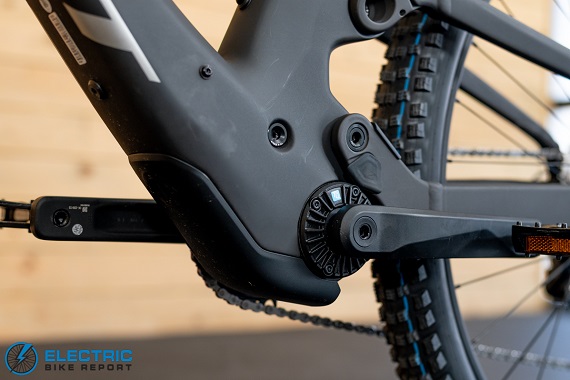
Sometimes the mid-drive unit is obvious, but TQ’s HPR50 is as small and discreet as you’ll find.
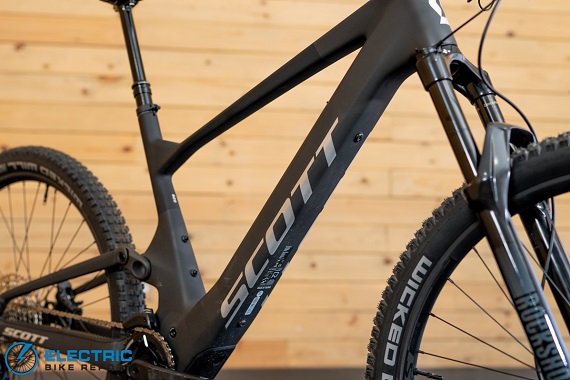
The Lumen is very stealthy. You wouldn’t know just from looking at the downtube that it packs in 360Wh of charge.
Scott Lumen Review: Motor & Battery
There may be no such thing as a perfect use case for a motor, but TQ’s HPR50 comes close for XC riding. The system is as light and unobtrusive as they come, yet it provides remarkably natural assistance despite the fact you know you’re boosted.
The secret sauce behind that precision is TQ’s patented Harmonic Pin Ring technology. Instead of relying on traditional gears or belts, it uses a double-tooth ring design where multiple teeth engage at once, transferring power through just a few precisely shaped parts. The result? A smaller, quieter, and more efficient motor with fewer components to wear out over time.
A lot of e-bike marketing centers on brute speed and power (all-mtn and enduros typically dominate headlines), this motor takes the opposite approach. There’s power here, no doubt, but this is a scalpel, not a hacksaw. It’s designed for refinement, helping riders pedal more efficiently rather than blasting them. It adds to your effort instead of replacing it, all while keeping sound to a whisper.
That balance even makes the Lumen a great training companion. Because the HPR50 provides such controlled assistance, it helps maintain steady heart-rate zones even on rolling or unpredictable terrain.
Like any system, it has a preferred cadence. Out of the box, the HPR50 feels at its best with faster cadences. For that reason, we’d suggest considering shorter crank arms—175mm feels a bit long unless you plan to ride with minimal motor support. A shorter setup better complements the motor’s natural rhythm.
The battery follows the same philosophy as the motor: lightweight, discreet, and efficient. The 360Wh pack is neatly tucked inside the downtube, keeping the frame’s lines clean and the handling sharp. With the motor producing 250W nominal and 300W peak, the pairing strikes a smart balance of range and responsiveness.
While the battery isn’t user-removable, it is expandable. Riders can replace one of the two bottle cage mounts with an optional 160Wh range extender—perfect for those longer trail days when you want to stay out just a bit longer.

With how light the Lumen is (41 lbs), you can get playful with it.

The Lumen’s display sits cleanly in the top tube. It’s fairly understated, which fits the theme.

The shock is concealed within the frame for some aesthetic appeal. You still get an external sag indicator on the linkage though to dial in the fit.
Scott Lumen Review: Display & App
The flush-mounted monochrome display integrates seamlessly into the top tube, giving the bike a clean, minimalist look. A simple battery bar tracks charge level, while expanding circles indicate your current assist mode. With a quick button press, you can toggle through the essentials—battery percentage, estimated range, speed, and power—keeping things streamlined and distraction-free.
TQ’s companion app follows the same minimalist philosophy. You can mount your phone on the handlebar to serve as a larger display for real-time ride data, or head into the tuning menu to adjust Eco, Mid, and High modes. Riders can fine-tune power output, overall assist strength, pedal response, and even top speed. (From a 235 lb rider’s perspective: Eco benefited from a touch more punch, while Mid and High felt perfectly balanced.)
Beyond tuning, the app includes a digital library of user guides and FAQs, plus ANT+ connectivity so you can pair a bike computer or smartwatch—perfect for syncing heart rate or ride stats across your fitness platforms.
Scott Lumen Review: Range Test
For our range testing, we run all bikes on a mix of green, blue, and black singletrack. Power demands can vary widely between riders, but to establish a consistent baseline, we conduct all tests in the highest assist mode and record total elevation gain to give a clear picture of a bike’s minimum expected range. It’s worth noting that our test loop is designed more for enduro and all-mountain bikes, so it’s a bit more demanding than the Lumen’s intended terrain.
In our test, the Lumen covered 15.6 miles while climbing 1,552 feet of elevation. With its 360Wh battery—one of the smaller packs in the eMTB category—that result was right in line with expectations.
Efficiency-wise, the Lumen impressed. eMTBs typically average around 25.6 watts per mile at full power, while the Lumen came in at 23.1 watts per mile. It’s not a huge battery, but it makes the most of every watt-hour.
Naturally, the more elevation you tackle, the more strain you’ll place on the motor, so we’d expect the Lumen to perform even better on flatter or rolling XC terrain. Still, this test gives a good idea of its lower range threshold.
And for riders who want more mileage, Scott offers a 160Wh range extender for a few hundred dollars extra. It replaces one of the two bottle cage mounts but still leaves room for one remaining bottle—an easy trade-off for roughly 44% more range.

Use the travel wisely! It’s shorter travel and steeper geo than you want for full rowdy downhills, but it can still handle the occasional harder drop.
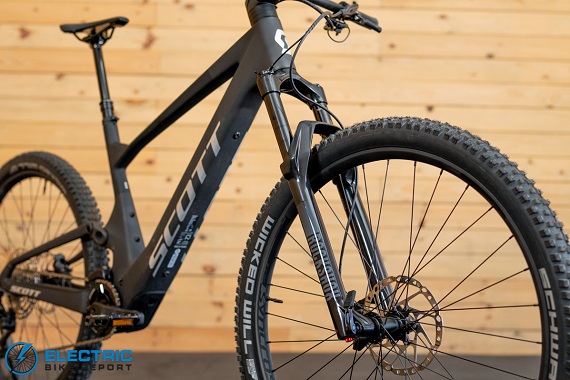
The front fork runs on the firm side, but has adjustment to fit your riding style.
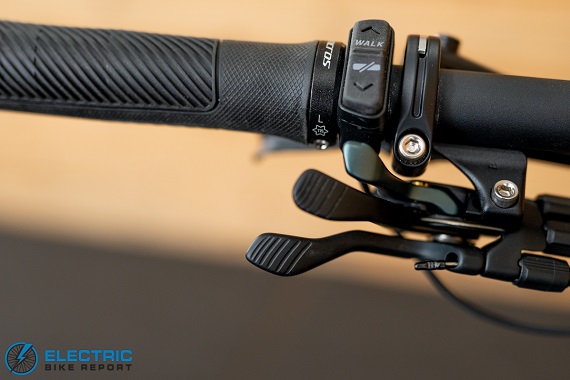
The Twinloc system integrates with the dropper post lever. You can shorten the travel, or fully lock it out without pulling over.
Scott Lumen Review: Hill Test
We put every eMTB through two climbs: one paved and one off-road. The paved climb, known as Devil’s Backbone, is where all e-bikes are tested. The off-road climb, Water Tower, is reserved exclusively for eMTBs.
On Devil’s Backbone, the Scott Lumen reached the top in 2 minutes and 47 seconds, averaging 10.9 mph. On the Water Tower climb, it clocked 4 minutes and 49 seconds, with an average speed of 10.8 mph. For comparison, the current eMTB averages across all tests stand at 2:09 and 3:36, respectively.
Those times are notably slower than the eMTB average—but that’s by design. The TQ HPR50 isn’t about brute force; it’s about balance. It helps you move forward, not just along for the ride. You’ll still outperform any non-electric bike while maintaining a traditional, natural pedal feel—and in that regard, it excels.
We see this motor as ideal for riders wanting to reclaim a few steps of fitness, keep pace with faster friends riding analog bikes, or use the bike as a controlled training tool to manage heart rate zones. It’s a perfect match for XC terrain—enough support to clear tough slopes, yet subtle enough to preserve the essence of the ride. It shaves down hills without erasing them entirely.
High-power seekers or heavier riders may prefer something with more torque, but for its intended purpose, the Lumen’s motor fits right in.
One final note: the Shimano Deore 12-speed drivetrain offers plenty of range and crisp shifting. We rarely needed the lowest gear, but it’s there when you do encounter steeper climbs.

Cable routing gets ran through the headset. An undeniable bit of eye-appeal, but it does make maintenance a bit trickier.

Flat bar with 760mm width. It’s a fairly clean and comfortable cockpit.
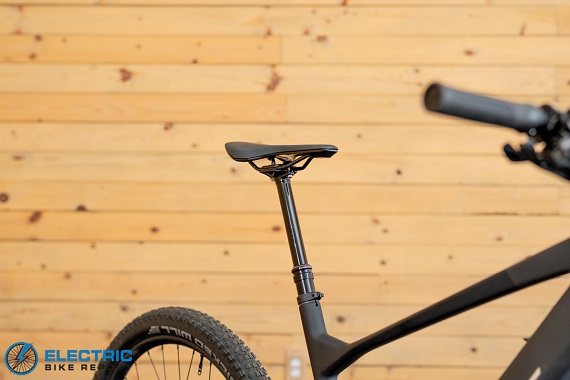
The Duncan dropper post worked reliably.
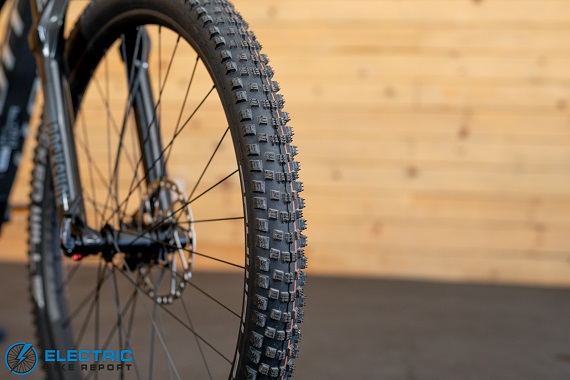
Wicked Will tires (fun name, BTW) held up well on our desert hardpack. It’s less ideal in softer terrain though.
Scott Lumen Review: Ride Quality
The Lumen’s frame is excellent. Its Carbon HMF construction keeps things light and confident—our size L test bike weighed just 41 lbs—and it’s available in four frame sizes for a solid fit. Geometry checks all the modern XC/trail boxes, with a 65.5° head tube and roughly 77° seat tube (depending on size). It climbs efficiently, carves through tight turns with precision, and feels playful when you want to pop off the trail.
The integrated suspension is another standout. It’s the kind of setup a casual observer might mistake for a hardtail, but the 130mm rear / 140mm front travel combo works beautifully. The RockShox Recon Gold fork and X-Fusion NUDE 5 shock offer enough adjustability to find your sweet spot, though they lean slightly firm rather than plush. A sag indicator on the suspension pivot removes the guesswork from setup.
Scott’s TwinLoc system adds even more control. With a handlebar lever, you can toggle between fully open suspension, a traction-control mode that shortens travel to 90mm, or a full lockout. It’s a clever system that maximizes pedaling efficiency and keeps the bike responsive across rolling terrain without diving too deep into its travel.
A couple of frame design choices come with tradeoffs. The integrated shock and adjustable headset routing make for a sleek, refined look, but they also complicate maintenance and part swaps. For shop-serviced riders, it’s a non-issue; for DIYers, it’s worth noting.
The wheels and tires are solid but leave room for upgrades. The Schwalbe Wicked Will tires roll fast on hardpack, with chunky shoulder lugs for grip, though they’re less at home on softer terrain. The stock wheels are a bit heavy—expected on the 920 base model—and a lighter set would noticeably improve agility. The Formula hubs have relatively low engagement, which isn’t a dealbreaker but feels more apparent on the Lumen’s modest power system. These are all serviceable components, but they’d be first in line for future upgrades.
The Shimano MT520 four-piston brakes deserve praise. XC e-bikes sometimes cut costs with two-piston setups, but Scott made the right call here—stopping power is consistent and confidence-inspiring.
A few elements come down to personal preference. The color scheme is tied to the spec level, limiting aesthetic options, and our testers were split on the grips and saddle comfort. Those details feel more restrictive at full price than they do at the discounted rates this outgoing model is seeing now. With the new-generation Lumen and TQ motor already on the scene, the 920 offers solid value—and with a few small upgrades, it can feel downright premium.
Overall this is a really competent trail bike. Good modern geo, lightweight build that’s snappy enough on the trails, All good things.
We liked a lot of the spec, and some things were serviceable, but worth considering upgrades. Suspension is on the firm and supportive side, but ovrall it’s nice. The brakes were nice 4-piston inclusions where some XC things bight just go for 2-piston ones. And the drivetrain works well.
Tires, wheels and hubs are sreviceable, maybe worth looking at upgrades. The Wicked wills held up well on our harderpack terrain, they’re not as good in softer things, even according to Schwalbe’s own website. And the wheels and hub are a bit slow. A higher engagement hub would be nice with the gentler motor power as it stood out a bit more than usual, and if you got lighter wheels you can shave the weight down even more to be more in the high 30s.

The cassette has plenty of workable range which is great to see on an XC bike with relatively light power. You can find the gear you need for any situation.
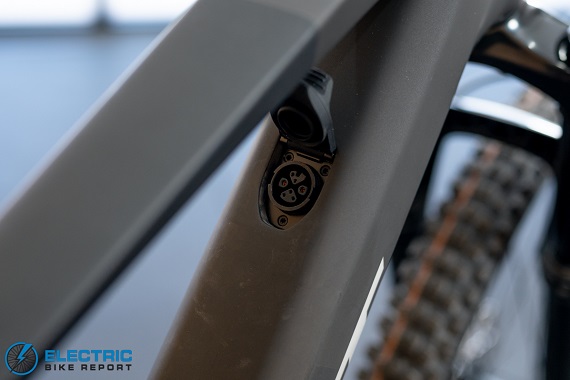
The battery cannot be removed for charging, but it’s easy enough with the port on the downtube.

As the 920 is the entry-level model, we were really happy to see brakes came with a 4-piston setup (many similar entry-level models just go for 2-piston.

The Twinloc system attachment point for firming up the travel into traction control, or locking it out for climbing.
Scott Lumen Review: Summary / Where to Buy
The Scott Lumen is a nimble ride that hardly lets the world know it’s electric—or even full suspension, for that matter. It’s a bike full of subtle, satisfying surprises.
Overall ride quality is excellent. This is a lively short-travel trail machine that handled our Utah desert terrain with ease. The TQ motor runs nearly silent, delivering a boost you can appreciate without robbing you of the workout—exactly the balance many XC riders are after.
Scott packed in several thoughtful components, from better-than-expected Shimano MT520 four-piston brakes to the versatile TwinLoc suspension system, which gives riders direct control over how the bike feels and responds on varying terrain.
Our test bike was the base model, so there are a few areas we’d look to upgrade over time. But with this being an outgoing generation, those upgrades are easier (and more affordable) than ever—or you can simply enjoy the solid stock build as is.
For XC riders looking for a little extra assistance, competitors searching for a smart training tool, or anyone who appreciates an e-bike that doesn’t drown out the sounds of nature, the Lumen delivers plenty of appeal.
Click below to find your nearest Scott dealer and experience it for yourself.
Happy Riding! Make sure to let us know if you have any questions or if you think we left anything out in this review of the Scott Lumen down in our comments section.



